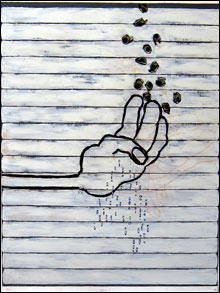
‘UNTITLED’ Oil on paper by Elizabeth Cashin McMillen, 2010. |
Paintings by Elizabeth Cashin McMillen and sculptures by Duane Paluska currently share the main gallery at the Center for Maine Contemporary in Rockport. The merely visual effect of this pairing is so pleasing to the eye that one could almost suspect the input of a designer. Horizontal lines in the paintings correspond to the linear quality of the sculptures. The playful imagery in the former bounces off the austerity and restraint of the latter. And the understated color palette of both seems related, ranging from muted greens and blues to browns and blacks, with a few highlights of red and pink.McMillen's paintings present her familiar style — body fragments drawn in black outlines float on bands of a single color that divide the dark underpaint into horizontal lines. Prior layers of paint can be discerned as well as deliberately retained pentimenti, traces of designs that have been altered. Human limbs, hands and feet, bare or shoed, reach into the image and perform curious actions — sprinkling or catching cascades of eyes, pressing up against each other, walking or prone. Small indeterminate shapes suggest tears or glass crystals, others possibly particles of skin. The arms and legs are so skinny and insubstantial that they do not displace the lines of the background. This treatment brings to my mind calavera, the macabre skeletons inhabiting so much of Mexican popular culture, in particular the satirical prints of José Guadalupe Posada (1852-1913); McMillen was born in Chicago but spent several years in Mexico City while growing up. The cartoonish style and content also relate the paintings to Philip Guston's deliberately crude figuration and street art's bold outlines and raw subjects.
While McMillen's paintings clearly suggest fragments of obscure narratives, there may not be a story after all. The bands of color convey a solidity that seems to shut out the world like drawn blinds. Feet, hands, and eyes are the predominant modes of perception and transportation to explore the world, yet McMillen seems to suggest that they can just as well stay home and find plenty of subject matter worth considering. "I resist leaving home. As though painting were a rhythm of procedure in a particular place and of collecting its space and time and maybe something else," she says in a handout available at the gallery. Possibly her paintings are metaphors of interiority.
In contrast to McMillen's lush paintings, Paluska's wooden sculptures are tightly controlled presences that are meticulously crafted with great attention to detail. The earlier work of 2009 continues his deconstructions of furniture, rearranging its constituting elements to vertiginous effect. What appear to be table legs and tops are realigned in various configurations, suggesting new spatial affinities, and supporting nothing but a challenge to our expectations. In his more recent work he departs from furniture making altogether and suggests other figurative references. "Ahab" (2010) remains spare and open to conjecture: standing 72 inches tall and painted off-white, a half-rounded base leg soars upward at a tilt, then down again at a sharp angle, all the while attenuating to a fraction of the initial diameter. Suggestions arise along the lines of Captain Ahab's wooden leg, the spouting of a whale, or a collapsible harpoon. Perhaps even more directly connecting his art to Moby-Dick, Paluska has a Ph.D. in English and American literature. The 2011 work constitutes a further departure — two-foot-tall table-top pieces are covered with canvas and lightly painted. Their surfaces evoke rich patinas, including those of bronze and copper, evoking compressed versions of minimalist sculpture of the '60s. The earlier grand, testosterone-driven statements become in Paluska's hands suggestions of bodily postures that are all complex angles, connections, and directions. Instead of keeping the viewer in awe and at bay, they draw us into a conversation about relationships. It is really this kind of wit that ties Paluska's and McMillen's work together, not any visual affinities.